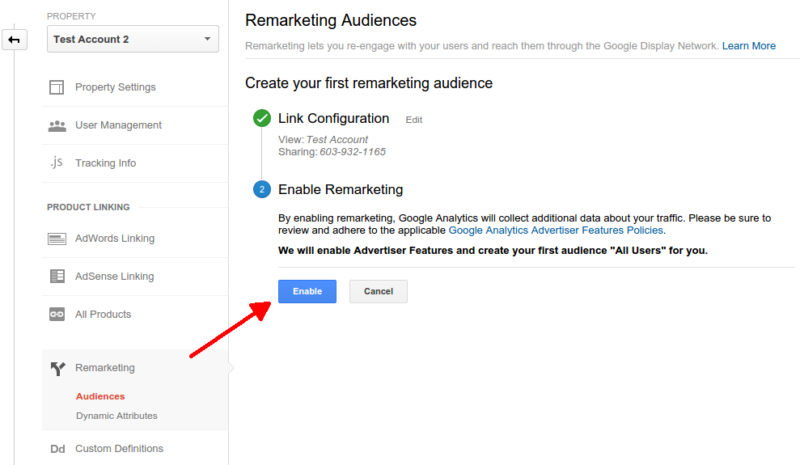The Advantages of Using Remarketing In Google Analytics
The Advantages of Using Remarketing In Google Analytics
Blog Article
Harnessing Remarketing in Google Analytics: A Comprehensive Guide
Harnessing remarketing in Google Analytics supplies companies a critical side in getting to out to potential customers. This overview will certainly lose light on the necessary actions included in using the complete capacity of remarketing in Google Analytics, leading to enhanced marketing results.
Understanding Remarketing in Google Analytics
Remarketing in Google Analytics permits services to strategically target individuals that have previously communicated with their website or mobile application. By leveraging data from Google Analytics, businesses can develop customized remarketing checklists based on individual behavior, such as pages gone to, actions taken, or details objectives achieved. This effective device enables companies to re-engage with individuals that have revealed passion in their product and services, ultimately boosting the chance of conversion.
Comprehending the different kinds of remarketing approaches is crucial for an effective campaign - What Is “Remarketing” In Google Analytics?. Google Analytics provides various options, including common remarketing, dynamic remarketing, and remarketing checklists for search advertisements (RLSA) Each type offers a distinct purpose and can be customized to meet particular advertising goals
In addition, evaluating the performance of remarketing projects is necessary for maximizing outcomes. Google Analytics supplies useful insights right into the performance of different remarketing techniques, enabling businesses to make data-driven decisions and fine-tune their targeting strategy. By constantly keeping an eye on and adjusting remarketing initiatives based on analytics data, organizations can make the most of ROI and drive success in their advertising and marketing efforts.
Setting Up Remarketing Campaigns

After establishing target market listings, the next action is to link Google Analytics with Google Advertisements. By connecting these 2 systems, organizations can effortlessly move audience listings from Google Analytics to Google Ads for remarketing purposes. This combination enables more accurate targeting and much better campaign performance.
As soon as the accounts are connected, companies can create remarketing campaigns in Google Advertisements making use of the target market notes formerly specified in Google Analytics. These projects can be personalized with particular ad creatives, messaging, and bidding strategies to effectively re-engage with previous site visitors and drive conversions. By complying with these actions, businesses can utilize the power of remarketing to boost their advertising and marketing efforts and enhance ROI.
Utilizing Target Market Segmentation Methods

Predefined sectors in Google Analytics allow you to rapidly examine usual target market categories like brand-new users, returning customers, or individuals who finished a specific objective on your website. Personalized sections, on the other hand, allow you to produce one-of-a-kind segments based on specific standards that are necessary to your organization purposes. Dynamic remarketing lists immediately change based on customer actions, revealing personalized check my site advertisements to users that have actually interacted with your website particularly ways.
Studying Remarketing Performance Metrics
Upon evaluating the effectiveness of remarketing campaigns in Google Analytics, the analysis of essential performance metrics supplies important understandings into audience interaction and conversion rates. By delving right into metrics such as click-through rates (CTR), conversion rates, cost per purchase (CPA), and return on advertisement spend (ROAS), marketers can evaluate the success of their remarketing initiatives. Analyzing these metrics makes it possible for marketing experts to optimize campaigns, fine-tune audience targeting, and allocate spending plans successfully to improve total remarketing efficiency.
Enhancing Remarketing Methods
When refining remarketing approaches in Google Analytics, concentrating on audience segmentation is paramount for achieving project success. By this post splitting your audience into details sections based upon their habits, demographics, or passions, you can customize your ads better per team. This targeted strategy boosts the possibility of involving users that have already shown rate of interest in your solutions or products, leading to greater conversion rates.
An additional vital facet of optimizing remarketing methods is continually testing and refining your campaigns (What Is “Remarketing” In Google Analytics?). A/B screening various ad creatives, messaging, or offers can assist you determine what resonates best with your audience and drives one of the most conversions. By examining the efficiency of these tests in Google Analytics, you can make data-driven decisions to enhance your remarketing initiatives better
Additionally, leveraging dynamic remarketing can dramatically enhance your campaign results. This function permits you to show individualized ads to individuals based on their past communications with your website, showcasing service or products they have actually previously viewed. By delivering customized web content to customers based upon their rate of interests and actions, dynamic remarketing can aid increase interaction and drive conversions.
Verdict
To conclude, taking advantage of remarketing in Google Analytics is a strategic method to target customers that have actually formerly involved with an internet site. By creating tailored audience checklists and utilizing audience division approaches, services can enhance remarketing projects for boosted conversion prices. Examining performance metrics and continually optimizing strategies are vital for optimizing the performance of remarketing initiatives.
Google Analytics offers various options, consisting of standard remarketing, dynamic remarketing, and remarketing lists for search advertisements (RLSA)After setting up target market lists, the next action is to link Google Analytics with Google Ads. By connecting these two platforms, businesses can perfectly move target market checklists from Google Analytics to Google Advertisements for remarketing purposes.Once the accounts are linked, businesses can develop remarketing campaigns in Google Advertisements making use of the target market provides formerly defined in Google Analytics.When refining remarketing methods in Google Analytics, focusing on audience segmentation is vital for achieving project success.
Report this page